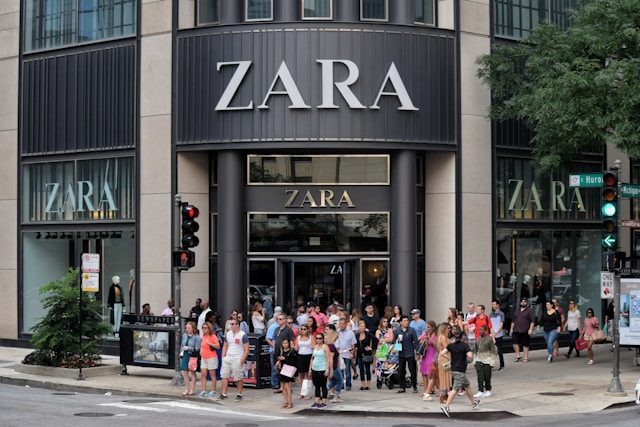Few brands have captured the essence of what it means to be both fashion trendsetter and retailer like Zara. Originating from Spain, Zara has grown into a global phenomenon, transforming the way consumers approach fashion. The secret behind Zara’s success lies in its marketing strategy, a blend of simplicity and speed that has revolutionized the industry.
The Foundation of Zara’s Strategy
At the heart of Zara’s marketing strategy is a commitment to understanding and meeting customer needs quickly. Unlike many competitors, Zara has built its business model around the concept of “fast fashion.” This term is more than a buzzword for Zara; it is the backbone of their operations. Fast fashion means getting designs from the runway to the store shelf in the shortest time possible, often within two weeks. This rapid turnaround is achieved through a streamlined supply chain and a unique approach to inventory management.
The Importance of Location
Zara’s choice of store locations is a critical part of its marketing strategy. Instead of sprawling malls or remote shopping centers, Zara targets high-traffic urban areas. Their stores are often found on prominent streets, making them accessible and visible to a large number of potential customers. This strategy is evident in cities like New York, London, and Paris, where Zara stores are strategically placed in bustling shopping districts.

Minimal Advertising, Maximum Impact
Unlike many fashion brands that invest heavily in advertising, Zara opts for a different approach. The company spends a mere 0.3% of its revenue on advertising, a stark contrast to industry giants like H&M. Instead of traditional advertising campaigns, Zara relies on word-of-mouth and the allure of its store windows. The brand’s minimalist and elegant window displays serve as silent yet powerful advertisements, drawing in passersby with their chic, ever-changing arrangements.
Customer Feedback and Data-Driven Decisions
Zara excels in using customer feedback to drive its design and production processes. Each store is equipped with an information system that allows managers to send feedback directly to the headquarters. This feedback includes details on what customers are looking for, what’s selling, and what’s not. This constant flow of information ensures that Zara can adapt quickly to changing trends and customer preferences.
Fast Fashion and Limited Availability
Zara’s strategy of fast fashion is complemented by the concept of limited availability. The brand produces limited quantities of each design, creating a sense of urgency among shoppers. Customers know that if they don’t buy a piece they like when they see it, it might not be available the next time they visit. This strategy not only drives sales but also reduces the risk of overstocking and markdowns.

Campaigns That Resonate
Zara’s marketing campaigns, though sparse, are impactful. A notable example is the “Dear America” campaign launched in 2017. This campaign featured a series of short films showcasing diverse American landscapes and the everyday lives of people wearing Zara clothing. The films were simple yet evocative, highlighting the versatility and timeless appeal of Zara’s designs. The campaign was a hit, resonating with consumers across the United States and beyond.
Another successful campaign was the launch of the Zara TRF line, aimed at younger customers. The campaign used social media platforms like Instagram and Snapchat to reach a younger demographic. Influencers and fashion bloggers were engaged to showcase the TRF line, creating a buzz that translated into strong sales.
Sustainability and Social Responsibility
In recent years, Zara has made strides in incorporating sustainability into its marketing strategy. The brand launched its Join Life collection, which features clothing made from sustainable materials like organic cotton and recycled polyester. Zara also promotes its sustainability efforts through in-store recycling programs and eco-friendly packaging. These initiatives are part of a broader strategy to appeal to environmentally conscious consumers and align the brand with global sustainability trends.
The Role of Technology
Zara’s embrace of technology is another key component of its marketing strategy. The brand uses sophisticated inventory management systems and data analytics to optimize its supply chain. Additionally, Zara has enhanced its online presence, offering a seamless shopping experience across its website and mobile app. The integration of online and offline channels ensures that customers can shop with ease, whether they’re in a store or on their smartphones.
Global Reach and Local Adaptation
While Zara operates on a global scale, it also adapts to local markets. The brand conducts extensive market research to understand the preferences and cultural nuances of different regions. This localization strategy is evident in Zara’s product offerings, which vary from country to country. For example, Zara stores in the Middle East offer more modest clothing options, while stores in Europe and North America might feature bolder designs. This ability to balance global reach with local adaptation has been instrumental in Zara’s success.
The Power of Simplicity and Speed
Zara’s marketing strategy is a testament to the power of simplicity and speed. By focusing on quick turnaround times, limited availability, and customer feedback, Zara has created a business model that is both efficient and effective. The brand’s minimal advertising approach, combined with impactful campaigns and a commitment to sustainability, has resonated with consumers worldwide.
In a world where fashion trends change rapidly, Zara’s ability to keep up and stay relevant is a remarkable achievement. For marketing professionals looking to be inspired by a success story, Zara offers valuable lessons in innovation, customer-centricity, and the importance of agility in today’s fast-paced market.
The Zara story is one of a brand that has mastered the art of staying ahead of the curve. It’s a story of a company that understands its customers and is willing to adapt to meet their needs. For anyone in the marketing field, Zara’s approach offers a blueprint for success in an ever-evolving industry.
Here are five key lessons that marketing professionals can learn from Zara’s approach:
1. Speed is Crucial
Zara’s fast fashion model emphasizes speed at every stage, from design to shelf. The company’s ability to turn around new designs in just two weeks sets it apart from competitors who may take months to release new collections. This rapid response to fashion trends ensures Zara stays relevant and meets customer demands promptly.
Lesson: Speed matters. Whether in product development, marketing campaigns, or customer service, being quick and responsive can give your brand a competitive edge.
2. Customer Feedback Drives Decisions
Zara integrates customer feedback directly into its design and production processes. Store managers relay information about customer preferences and sales trends back to the headquarters, allowing Zara to adjust its inventory and designs in real-time.
Lesson: Listening to your customers is invaluable. Use customer feedback to guide your decisions, ensuring that your products and services align with what your audience wants and needs.
3. Scarcity Creates Demand
By producing limited quantities of each design, Zara creates a sense of urgency among shoppers. Customers know that if they don’t buy something they like immediately, it might not be available later. This strategy not only boosts sales but also minimizes excess inventory and markdowns.
Lesson: Creating a sense of scarcity can drive demand. Limited-time offers, exclusive products, and small-batch releases can encourage customers to act quickly and increase the perceived value of your products.
4. Minimal Advertising, Maximum Impact
Zara spends very little on traditional advertising, relying instead on word-of-mouth, strategic store placements, and eye-catching window displays. Their campaigns, when they do occur, are impactful and well-targeted.
Lesson: Advertising doesn’t always require a massive budget. Focus on creating a strong brand presence through quality, visibility, and customer experience. Effective use of visual merchandising and targeted campaigns can have a significant impact without excessive spending.
5. Embrace Sustainability
Zara has incorporated sustainability into its brand strategy with initiatives like the Join Life collection, in-store recycling programs, and eco-friendly packaging. These efforts appeal to environmentally conscious consumers and align the brand with global sustainability trends.
Lesson: Sustainability is not just a trend; it’s a critical aspect of modern business strategy. Implementing sustainable practices can enhance your brand’s reputation, meet consumer expectations, and contribute to long-term success.

